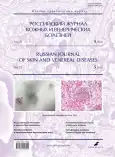Changes in the serum levels of anti-inflammatory interleukins in patients with atopic dermatitis after a course of phototherapy
- Authors: Plakhova K.I.1, Khasanova A.R.1, Tarasenko G.N.1, Shadyzheva L.I.1
-
Affiliations:
- Russian Medical Academy of Continuous Postgraduate Education
- Issue: Vol 23, No 5 (2020)
- Pages: 317-323
- Section: CLINICAL PICTURE, DIAGNOSIS, AND THERAPY OF DERMATOSES
- URL: https://journals.rcsi.science/1560-9588/article/view/49848
- DOI: https://doi.org/10.17816/dv49848
- ID: 49848
Cite item
Abstract
BACKGROUND: The role of immunological disorders in the development of atopic dermatitis (AD) is currently beyond doubt.
AIMS: Changes in the serum levels of IL-4, IL-10 and IL-13 in patients with atopic dermatitis (AD) after UV therapy combined with standard drug treatment have been studied.
MATERIALS AND METHODS: The study included 80 patients with moderate to severe AD and 80 healthy volunteers. The patients with AD received a course of 311 nm UVB phototherapy combined with standard drug therapy. Serum IL-4, IL-10 and IL-13 levels were determined through enzyme-linked immunosorbent assay (ELISA).
RESULTS: In the studied sample, patients with AD were found to have statistically significantly higher serum levels of IL-10 and IL-13 compared with healthy volunteers of the control group. Serum IL-10 level was 18.3 pg/ml in patients with AD and 13.2 pg/ml in those of the control group; the level of IL-13 was 15.8 pg/ml and 11.5 pg/ml, respectively; after the course of 311 nm UVB, serum IL-10 and IL-13 levels in patients with AD decreased (IL-10 by 27.8% and IL-13 by 12.5%). IL-4 values did not differ significantly in patients with AD and those in the control group, being 0.06 pg/ml and 0.05 pg/ml, respectively; after the course of phototherapy, serum IL-4 levels remained unchanged and were equal to 0.05 pg/ml.
CONCLUSION: The results obtained confirm the assumptions about the significant role of IL-10 and IL-13 in the mechanisms of AD regulation and pathogenesis and demonstrate the anti-inflammatory efficacy of phototherapy (311 nm UVB) in patients with severe and moderate AD.
Keywords
Full Text
##article.viewOnOriginalSite##About the authors
Kseniya I. Plakhova
Russian Medical Academy of Continuous Postgraduate Education
Author for correspondence.
Email: plahova_xenia@mail.ru
ORCID iD: 0000-0003-4169-4128
MD, PhD, DSc, docent of Dermatovenerology and Cosmetology Department
Russian Federation, MoscowA. R. Khasanova
Russian Medical Academy of Continuous Postgraduate Education
Email: plahova_xenia@mail.ru
ORCID iD: 0000-0001-7884-6442
Russian Federation, Moscow
G. N. Tarasenko
Russian Medical Academy of Continuous Postgraduate Education
Email: plahova_xenia@mail.ru
ORCID iD: 0000-0001-6504-4782
Russian Federation, Moscow
L. I. Shadyzheva
Russian Medical Academy of Continuous Postgraduate Education
Email: plahova_xenia@mail.ru
SPIN-code: 4199-0359
Russian Federation, Moscow
References
- Albanova VI. Atopic dermatitis: textbook. Moscow: GEOTAR-Media; 2014. (in Russian)
- Elisyutina OG, Fedenko ES, Boldyreva MN, Gudima GO. Characteristics of immune response and role of cytokines in atopic dermatitis. Russian Journal of Allergology. 2015;(1):3-14. (in Russian)
- Ong PY, Leung DY. Immune dysregulation in atopic dermatitis. Curr Allergy Asthma Rep. 2006;6(5):384-9.
- Volkova EN, Morozov SG, Tarasova MV, Grigorieva AA, Elistratova IV. A study of the level of circulating cytokines in patients with atopic dermatitis. Herald of Dermatology and Venerology. Russian Journal. 2014;(2):26-30. (in Russian)
- Petrishcheva IV, Tsybikov NN, Fefelova EV, Tereshkov PP. Dynamics of interleukins in atopic dermatitis during exacerbation and remission. Transbaikalian Medical Bulletin. Russian Journal. 2014;(4):101-4. (in Russian)
- Balabolkin II, Tyumentseva ES. Influence of genetic factors on the development of atopic dermatitis in children. Russian Journal Pediatria n.a. GN Speransky. 2009;87(2):125-9. (in Russian)
- Varlamov EE, Elisyutina OG, Vinogradova TV, Fedenko ES, Pampura AN. Age-related pathogenetic specificity of cytokine profile in atopic dermatitis patients. Russian Journal of Allergology. 2016;(4-5):37-42. (in Russian)
- Vinogradova TV, Chuslyaeva AA, Varlamov EE, Ruzhitskaya EA, Sukhorukov VS, Pampura AN. Current evaluation of the cytokine status of children with atopic dermatitis. Russian Bulletin of Perinatology and Pediatrics. 2014;59(1):76-81. (in Russian)
- Hilgenberg E, Shen P, van Duc Dang, Ries S, Sakwa I, Fillatreau S. Interleukin-10-producing B cells and the regulation of immunity. Curr Top Microbiol Immunol. 2014;380:69-92.
- Оlisova OYu. Psoriasis: epidemiology, pathogenesis, clinic, treatment. Consilium Medicum. Russian Journal. Dermatology. 2010;(4) 3-8. (in Russian)
- Petrishcheva IV. Modern theories of pathogenesis of atopic dermatitis. The Transbaikalian Medical Bulletin. Russian Journal.2014;(4):169-77. (in Russian)
- Sergeev AYu, Karaulov AV, Sergeev YuV. Immunodermatology: immunological bases of pathogenesis of main inflammatory dermatoses of humans. Immunopathology, Allergology, Infectology. Russian Journal. 2003;(3):10-23. (in Russian)
- Volnukhin VA, Samsonov VA. UFA-1 therapy of localized scleroderma and other diseases accompanied by skin sclerosis. Herald of Dermatology and Venerology. Russian Journal. 2013;(5):50-68. (in Russian)
- Monakhov SA, Korchazhkina NB, Olisova OYu. Narrow-band 311 nm phototherapy of patients with atopic dermatitis. Russian Journal of Skin and Venereal Diseases. 2012;(3):25-7. (in Russian)
- George SA, Bilsland DJ, Johnson BE, Ferguson J. Narrow-band (TL-01) UVB air-conditioned phototherapy for chronic severe adult atopic dermatitis. Br J Dermatology. 1993;128(1):49-56.
- Alipov NV. Phototherapy in atopic dermatitis: modern possibility of using (review). Saratov Journal of Medical Scientific Research. Russian Journal. 2014;10(3):518-21. (in Russian)
- Goryacheva TA, Samsonov VA, Nadgeriyeva OV, Volnukhin VA. Clinical results of narrow-band (311 nm) phototherapy in patients with atopic dermatitis. Russian Journal of Skin and Venereal Diseases. 2009;12(3):22-5. (in Russian)
- Grewe M, Gyufko K, Krutmann J. Interleukin-10 production by cultured human keratinocytes: regulation by ultraviolet B and ultraviolet A1 radiation. J Invest Dermatol. 1995;104(1):3-6.
- Bakulev AL, Slesarenko NA, Platonova AN, Igonina IA, Kulyaev KA. Efficacy of using a narrow-band 311 nm mid-wavelength ultraviolet therapy at atopic dermatitis in children. Herald of Dermatology and Venerology. Russian journal. 2010;(2):37-42. (in Russian)
- Proshutinskaya DV, Chikin VV, Znamenskaya LF. Federal clinical recommendations for the management of patients with atopic dermatitis. 2015. Available at: https://www.cnikvi.ru/docs/clinic_recs/bolezni-kozhi-i-pridatkovkozhi/atopicheskiy_dermatit (in Russian)








